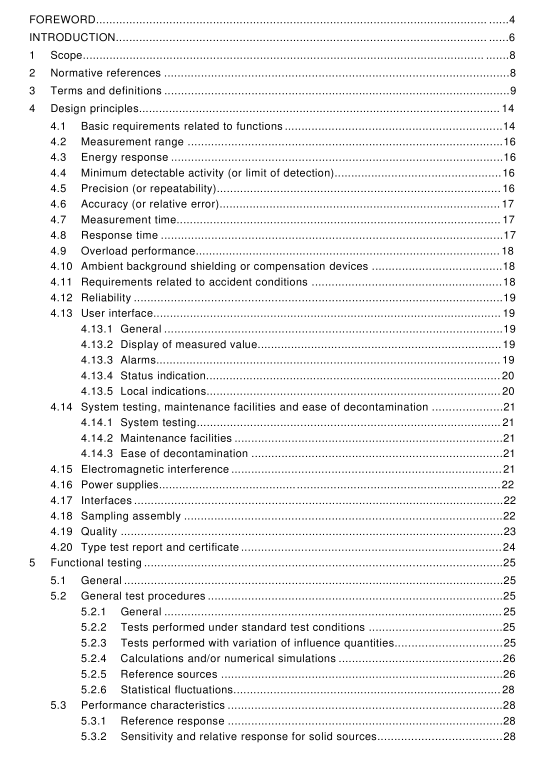BS IEC 60951-1 pdf – Nuclear power plants — Instrumentation important to safety — Radiation monitoring for accident and post-accident conditions — Part 1: General requirements

BS IEC 60951-1 pdf – Nuclear power plants — Instrumentation important to safety — Radiation monitoring for accident and post-accident conditions — Part 1: General requirements
4 Design principles
4.1 Basic requirements related to functions The main purpose of equipment for continuous monitoring of radioactivity in accident or post- accident conditions is to continuously measure radiation levels in appropriate areas and processes. These radiation measurements are displayed locally and/or in control rooms and/or incident control centers to keep plant operators aware of current radiological conditions. This information is used by operators to assess plant conditions, take appropriate actions in order to mitigate the consequences of a plant accident and prevent the inadvertent release of radiation, and by site emergency personnel, national authorities, for actions necessary to safeguard public and plant personnel. Therefore, the equipment concerned by this standard is capable of actuating alarms and providing inputs to other plant systems and processes to isolate processes at abnormal radiation levels. The basic requirements for the design, selection, testing, calibration and functional location of equipment for continuous monitoring of radioactivity in accident or post-accident conditions are plant specific. It is typically split into three key parts, effluent and ventilation radiation monitoring, process radiation monitoring, and area radiation monitoring:
• Effluent and ventilation radiation monitors measure the radioactivity in gases released into the environment in accident and post-accident conditions to ensure that the radiation levels are not hazardous to the public’s safety and to help in early warning and process isolations, such as containment vent isolation or control room habitability. Effluent radiation monitors are usually of the off-line type (radioactivity is measured in a sample drawn from the effluent or ventilation system).
• Process radiation monitors measure the radioactivity in a fluid (either gas, liquid or steam) and are normally used in plant process to help in early warning and process isolations, such as detecting reactor coolant pressure boundary leaks into containment and other systems. Process radiation monitors can be classified into three basic types:
• In-line monitors: the detector is located directly in the process stream (pipe, stack, tank, duct, etc.).
• On-line monitors: the detector directly faces the process stream.
• Off-line monitors: a sample is drawn from the process stream to the detector located at some distance.
• Area radiation monitors (wide range type) are strategically located within buildings subject to high range dose rates in accident and post-accident conditions, such as the reactor building, and serve as post-accident monitoring devices. Area radiation monitors are wall mounted in the area or tank to be monitored. Depending on the radiation level at the detector position, the electronics part of the monitor may be located at some distance from the detector. For the purpose of critical data collection, these monitors are usually designed to withstand adverse environmental and seismic conditions, during and after an accident. Radiation monitoring requirements and radiation monitoring system design should be addressed early in Plant design to establish effective monitoring at the appropriate sensitivity evel. Thus, for maximum performance capability, the following procedure should be followed by the purchaser and the manufacturer: • Establish the required measurement characteristics (purchaser):
• Determine the scenarios of normal and accidental operations, and the corresponding source terms (main isotopes to be measured by the monitor), including their chemical composition.
• Determine the essential information required by the plant operator or the control system to initiate emergency actions, the functions assigned to the equipment for continuous radiation monitoring and classify them according to IEC 61 226 guidance.
• Determine the optimum points of measurement taking into account installation conditions (location, interfaces to plant protection features, ambient conditions and qualification requirements, electrical connections through safety barriers, etc.).
• Calculate the activity transfers (propagation through pipes or ducts and through the safety barriers), in order to determine the activity spectrums and the background at the point of measurement.
• Determine the time profile of the postulated release and the required range of measurement and response time of the complete channel (including the sampling system, if any, and the time to send or to display the information to the plant operator or the control system).
• Determine the gross characteristics of the detectors (type of radiation and measurement, sensitivity and range of measurement, energy response and overload performance, etc.) and of the sampling system, if any.









